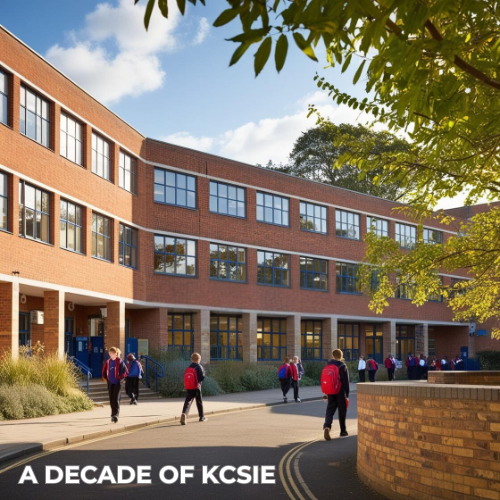Keeping Children Safe in Education Statutory
Guidance (2021) and The Student Voice
Safeguarding is everybody’s responsibility, but student safeguarding is an especially essential part of all roles within a school or college.
According to government guidance, keeping children and young people safe is expected to be taking a ‘whole school or college approach’, with more responsibilities being placed on schools to work with social care and in multi-agency partnerships.
Government Guidance (Keeping Children Safe in Education, 2020 and 2021)
Keeping Children Safe in Education (2020) statutory guidance emphasises the importance of recognising that ‘extra familial harm’ can take place outside of the home and family, in locations that young people spend time with their peers and community at large, such as school and local neighbourhoods. High profile cases circulating the news and horrifying the nation such as the case of the Rotherham grooming scandal, where vulnerable young girls were targeted and abused by a circle of predators that went undetected for several years, confirm the importance of community safeguarding.
Keeping Children Safe in Education (2021) also provides guidance for schools to establish clear reporting lines, emphasising the necessity of having clear systems in place for young people to confidentially report concerns and give feedback. This update has the clear objective of preventing harm of any kind from coming to young people outside both the home and school environment.
Get our blogs sent straight to your inbox.
Keeping Children Safe in Education (KCSIE, 2020) – Contextual Safeguarding
“21. All staff should be aware that safeguarding incidents and/or behaviours can be associated with factors outside the school or college and/or can occur between children outside of these environments. All staff, but especially the designated safeguarding lead (and deputies) should consider whether children are at risk of abuse or exploitation in situations outside their families. Extra-familial harms take a variety of \ different forms and children can be vulnerable to multiple harms including (but not limited to) sexual exploitation, criminal exploitation, and serious youth violence.”
Keeping Children Safe in Education (KCSIE, 2021) – Reporting
“83. Where there is a safeguarding concern, governing bodies, proprietors and school or college leaders should ensure the child’s wishes and feelings are taken into account when determining what action to take and what services to provide. Systems should be in place, and they should be well promoted, easily understood and easily accessible for children to confidently report abuse, knowing their concerns will be treated seriously, and knowing they can safely express their views and give feedback.”
It is also expected that this approach should be monitored and kept on track with a Designated Safeguarding Lead, referring them at a higher level when needed, supporting staff at the school or college with advisory and up to date training, and continually raising awareness of child protection procedures throughout the school.
How can we facilitate DSLs and school leaders in their roles to protect their students?
Listening to students – Empowering students to look after their community will have positive change.
Whilst over a third of all teachers have access to electronic safeguarding logging systems, being responsible for hundreds of students has the potential to let many slip through the net. Equally, an adult’s perception of what is going on in a young person’s life may not always be accurate.
Encouraging a culture of listening to students can be challenging in an environment where children and young people can be both discouraged by their peers from coming forward, through fear of being ostracised, and trust in adults not always being present. The idea that a mature adult wouldn’t ‘get it’ can be a barrier, as can a lack of confidence in interacting with those older than themselves. This can be especially difficult when discussing topics students are uncomfortable talking about face to face.
Young people are experiencing record levels of mental health issues, including hugely problematic societal issues around harmful sexual behaviour and peer on peer abuse, with studies showing in an average group (30) of 15 year olds, 7 are likely to have been bullied, 6 may be self harming, and in cases of reporting HSB (where the abuse occurred 12 or more months prior to being reported), non-recent cases accounted for 34% of all sexual offences against children recorded by the police in the year ending March 2019.
In Simon Sinek’s “A bit of Optimism” podcast, he says through talking to many young people, some “struggle to form deep meaningful relationships even though they love the company of their friends and have fun with their friends, in a dark time, they wouldn’t call their friends.” (Simon Sinek ‘A bit of Optimism’, Episode 35, Raising Resilient Kids with Angela Duckworth, psychologist and professor at the University of Pennsylvania and author of Grit).
Finding a way to make communication easier and develop positive, trustful and meaningful relationships within school communities is essential. The use of technology designed for the purpose of keeping students safe can offer students a way to interact that they are more comfortable with. By offering a more secure feeling of anonymity, this may be an ideal option for a generation that grew up never knowing a time where smartphones, tablets and computers weren’t widely and easily available.
Prior cases where this technology has been rolled out have generated positive responses from both Ofsted and teachers, as well as offering students new changes to policy based on their experience.
Hotspot Mapping
Hotspot maps identify key areas of harm to improve the safety of your school and local community for students, including the home environment, and help you to engage in a multi-agency approach to improving local areas. It is important to know what happens, where and when to understand the contextual trends in your school, in local areas, online and outside of school so you can allocate staff supervision better. Examples include:
School: Issues of sexual harassment take place in the sixth form centre at lunchtime, when there is limited adult supervision.
Community: Students do not feel safe at the end of the day walking past the other local secondary school, as they are being harassed and bullied by older students from that school.
Measuring Interventions and Targeted Allocation of Resources
UK Statutory guidance highlights the importance of providing early intervention, rather than waiting until a child or family’s situation escalates (Department for Education (DfE), 2018; Department of Health, Social Services and Public Safety, 2017; Scottish Government, 2014; Welsh Government, 2018).
Research suggests that in addition to the fact that early intervention can improve a child’s long-term outcomes, it can also reduce the need for a referral to child protection services (Haynes et al, 2015)., which can be resource heavy on schools. Through measuring the effectiveness of your inventions and monitoring which areas improve over time, schools can have a stronger understanding of where to spread school resources and keep within budget.
If we told you there was a way to transform your school community, student advocacy and proactively intercept safeguarding concerns, would you want to see it?
The Student Voice has developed a contextual safeguarding information sharing tool that seeks to provide a safe platform and environment for community leaders and young people to understand and share concerns and worries. We are seeking to bridge the perceived communication gap by listening to young people and allowing communities to respond to their concerns effectively; with the overall aim being to proactively identify and intercept safeguarding issues, and to ultimately protect our students and provide them with a forum to play their part in this process.
- Encourages students to take ownership of their community and share their concerns, as well as what is positive and working well. Schools can learn things students like and build upon positive aspects of student life.
- Designed appropriate to age. Students access and easily navigate interactive maps of school campus and local areas to report experiences and feedback
- Provide a comfortable experience on a student’s terms. They can access on any device, anywhere, so they don’t have to approach teachers or school leaders with their concerns face to face.
- Empower schools and DSLs to monitor and intercept issues before they escalate, identify real time hotspots, monitor vulnerable groups, prioritise feedback and create extensive reports easily
- Schools can allocate resource effectively by knowing hotspots and vulnerabilities
- Protects the school by using their local authority support windscreen to link cases to the level of intervention needed, encouraging schools and multi agencies to work together to improve schools and local communities.
- Provides schools with the context of issues happening in their school community and in local area hotspots
Product backup & evidence
Over the last 3 years we have been developing an innovative and pioneering safeguarding system unlike anything accessible to schools and DSLs at this moment.
- Piloted, implemented and applauded by young people (11-18 age setting) throughout state, private and international schools.
- A product based in learning, education and safeguarding. Developed and fine-tuned with guidance from DSLs and leading safeguarding experts and consultants.
- Reviewed by members of NSPCC, ASCL, Dr Jenny Lloyd and the contextual safeguarding team at The University of Bedfordshire.
- Constantly evolving, even adapted in response to key crisis, such as Covid-19 lockdown where students are adjusting to home learning to better support young people through the pandemic.
Why long term, live data is needed to tackle long terms issues:
The Wirral Safeguarding Children Partnership survey from 2000 young people displays the power of a live data contextual safeguarding reporting tool like ours (The Student Voice) and the role it can have in improving the safety of schools and local communities.
We strongly believe The Student Voice tool has the potential to transform how school communities can take responsibility for proactively safeguarding the children in their care. It is a genuine attempt to place students at the centre of school communities and empower their voice.





